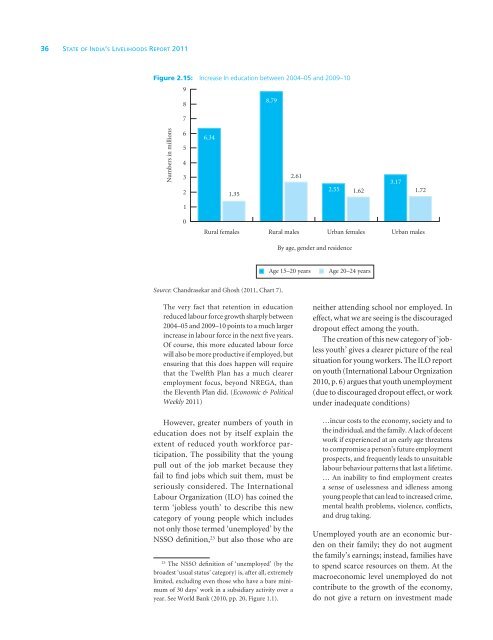SOIL Report 2011 - ACCESS Development Services
SOIL Report 2011 - ACCESS Development Services
SOIL Report 2011 - ACCESS Development Services
- No tags were found...
Create successful ePaper yourself
Turn your PDF publications into a flip-book with our unique Google optimized e-Paper software.
36 State of India’s Livelihoods <strong>Report</strong> <strong>2011</strong>Figure 2.15: Increase In education between 2004–05 and 2009–10Source: Chandrasekar and Ghosh (<strong>2011</strong>, Chart 7).The very fact that retention in educationreduced labour force growth sharply between2004–05 and 2009–10 points to a much largerincrease in labour force in the next five years.Of course, this more educated labour forcewill also be more productive if employed, butensuring that this does happen will requirethat the Twelfth Plan has a much cleareremployment focus, beyond NREGA, thanthe Eleventh Plan did. (Economic & PoliticalWeekly <strong>2011</strong>)However, greater numbers of youth ineducation does not by itself explain theextent of reduced youth workforce participation.The possibility that the youngpull out of the job market because theyfail to find jobs which suit them, must beseriously considered. The InternationalLabour Organization (ILO) has coined theterm ‘jobless youth’ to describe this newcategory of young people which includesnot only those termed ‘unemployed’ by theNSSO definition, 23 but also those who are23The NSSO definition of ‘unemployed’ (by thebroadest ‘usual status’ category) is, after all, extremelylimited, excluding even those who have a bare minimumof 30 days’ work in a subsidiary activity over ayear. See World Bank (2010, pp. 20, Figure 1.1).neither attending school nor employed. Ineffect, what we are seeing is the discourageddropout effect among the youth.The creation of this new category of ‘joblessyouth’ gives a clearer picture of the realsituation for young workers. The ILO reporton youth (International Labour Orgnization2010, p. 6) argues that youth unemployment(due to discouraged dropout effect, or workunder inadequate conditions)…incur costs to the economy, society and tothe individual, and the family. A lack of decentwork if experienced at an early age threatensto compromise a person’s future employmentprospects, and frequently leads to unsuitablelabour behaviour patterns that last a lifetime.… An inability to find employment createsa sense of uselessness and idleness amongyoung people that can lead to increased crime,mental health problems, violence, conflicts,and drug taking.Unemployed youth are an economic burdenon their family; they do not augmentthe family’s earnings; instead, families haveto spend scarce resources on them. At themacroeconomic level unemployed do notcontribute to the growth of the economy,do not give a return on investment made














